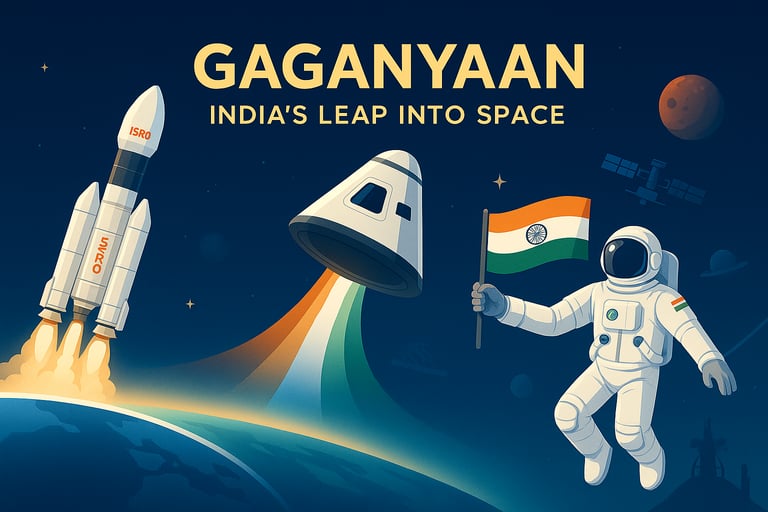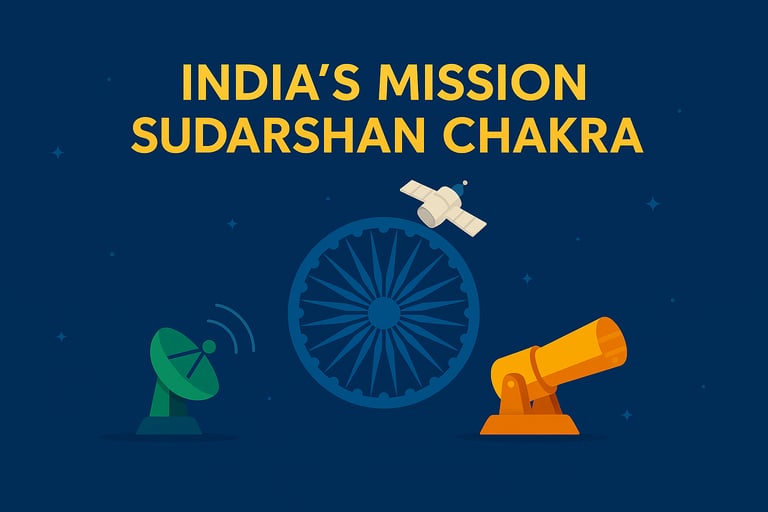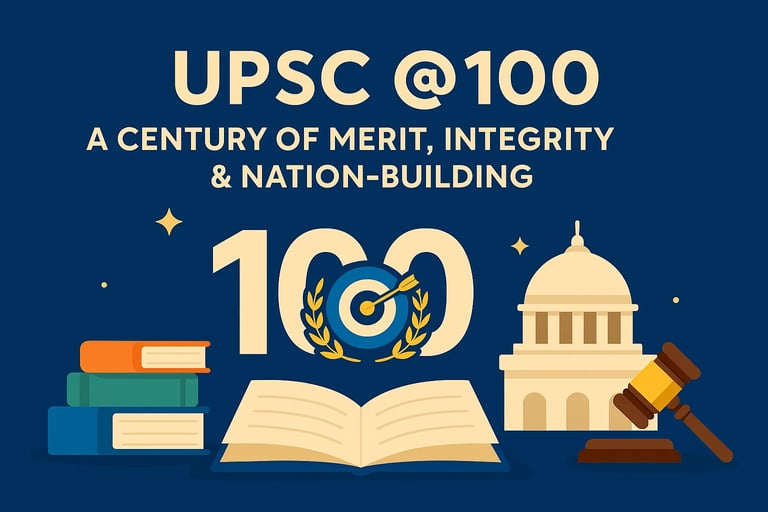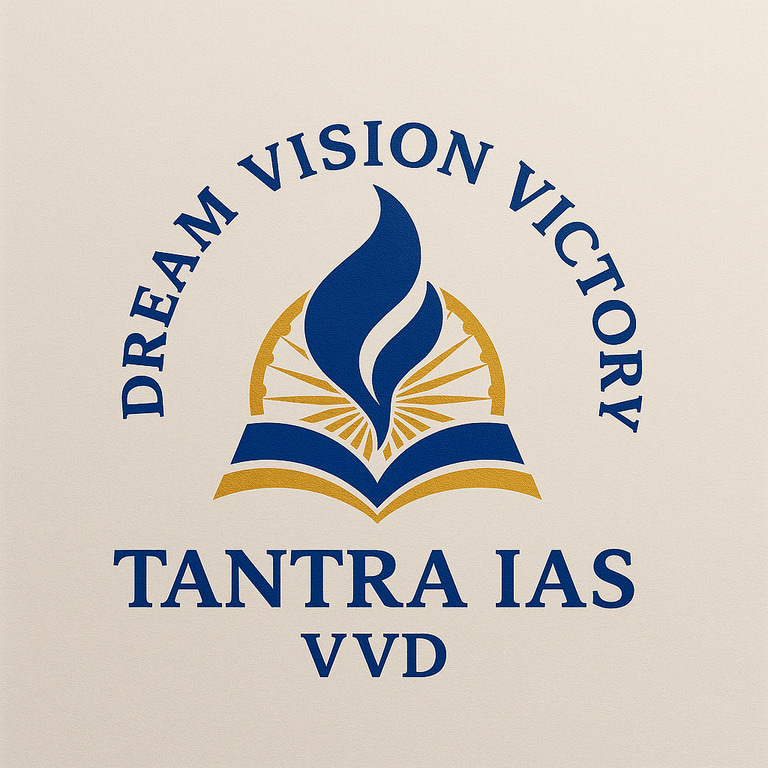🚀 GAGANYAAN: INDIA’S LEAP INTO SPACE
Theme: Science & Technology | Indigenisation | Space Technology
🌍 Context
Gaganyaan Mission, led by ISRO, aims to send a 3-member Indian crew into low Earth orbit (400 km) for 3 days and bring them safely back to Earth. It represents India’s entry into the elite group of nations with human spaceflight capability — after the USA, Russia, and China.
🛰️ Features
🔹 Crew Module (CM): Pressurised capsule carrying astronauts with life support and emergency systems.
🔹 Service Module (SM): Supplies power, propulsion, and thermal control.
🔹 Launch Vehicle: HLVM3 (Human-rated LVM3).
🔹 Training: Astronauts trained in India and Russia; Gaganyaan Astronaut Training Facility in Bengaluru.
🔹 Safety Systems: Crew Escape System (CES) tested successfully.
🔹 Mission Partners: ISRO, DRDO, HAL, BEL, IN-SPACe, and private tech firms.
⚙️ Objectives
✅ Validate indigenous spaceflight capability.
✅ Strengthen aerospace R&D, robotics, and life-support systems.
✅ Inspire youth & promote STEM innovation.
✅ Build international collaboration for deep space missions (e.g., LUPEX, Chandrayaan-Next).
🧭 UPSC Mains Relevance (GS Paper 3):
Science & Technology: Achievements of Indians in space technology.
Indigenisation: Development of indigenous launch vehicles & space tech.
Security: Strategic & scientific self-reliance under “Atmanirbhar Bharat”.
🎯 UPSC Prelims Relevance:
Possible MCQ Angles:
1️⃣ Gaganyaan involves Human-rated LVM3 launch vehicle.
2️⃣ Crew Module designed for re-entry & safe landing in Indian Ocean.
3️⃣ Mission partners include ISRO, DRDO, HAL, BEL.
4️⃣ Training collaborations with Russia’s Gagarin Cosmonaut Training Center.
5️⃣ HLVM3 stands for Human Launch Vehicle Mark-3.
💡 Significance
✅ Positions India as a global space power.
✅ Boosts indigenous innovation & manufacturing.
✅ Expands private sector & academia participation in space ecosystem.
✅ Strengthens “IndiaAI” & advanced robotics integration for future missions.
⚖️ Challenges
⚠️ High cost & complexity (~₹9,000 crore).
⚠️ Astronaut safety, life support validation, re-entry precision.
⚠️ Maintaining global cooperation amid strategic competition.
🧩 Conclusion
Gaganyaan is not just a space mission — it’s India’s declaration of scientific confidence, technological maturity, and visionary ambition.
🧠 Topper’s Toolkit
Keyword: “Human-rated launch vehicle.”
Quote: “Space exploration is the ultimate expression of human curiosity and courage.”
Diagram Idea: Gaganyaan architecture — Crew Module, Launch Vehicle, Orbital Path.
UPSC PYQ:
Q. Consider the following space missions: (UPSC PRE-2025)
I. Axiom-4
II. SpaDeX
III. Gaganyaan
How many encourage mesogravity research?
Only one
Only two
All three
None
ANSWER: Option 3: All three.
Explanation: All three missions — Axiom-4, SpaDeX, and Gaganyaan — encourage mesogravity (microgravity/low-gravity) research.
Axiom-4: Conducts multiple microgravity experiments aboard the International Space Station (ISS) related to human physiology and space biotechnology.
SpaDeX (Space Docking Experiment): Though primarily a technology demonstrator for autonomous docking, it also carries several payloads designed for experiments utilizing the microgravity environment in orbit.
Gaganyaan: India’s human spaceflight programme aims to facilitate a range of microgravity experiments in life sciences, material sciences, and space medicine through its orbital module.
✅ Final Answer: 3


DAILY UPDATES
UPSC CURRENT AFFAIRS
MISSION SUDARSHAN CHAKRA
Theme: Internal Security | Science & Technology | Defence Infrastructure
⚡ Context
India’s Mission Sudarshan Chakra will establish a nationwide multi-layered air defence shield by linking 6,000–7,000 radars, satellites, and directed-energy weapons (DEWs). It represents a landmark move towards an indigenous, technology-driven defence ecosystem.
⚙️ Key Features
🔹 Layered Shield: Tracks aerial threats beyond the horizon through an integrated radar-satellite-AI network.
🔹 Satellites: Enable real-time surveillance of hostile launches and incursions.
🔹 Directed Energy Weapons (DEWs): Laser-based systems to neutralise enemy drones and missiles.
🔹 Integration: Combines radars, DEWs, anti-drone systems, and air-defence guns.
🔹 Institutions Involved: DRDO, ISRO, BEL, armed forces, paramilitary, and defence PSUs under a unified Strategic Coordination Framework.
🧭 UPSC Mains Relevance (GS Paper 3)
Internal Security: Modernisation of armed forces; defence preparedness.
Science & Technology: Application of lasers, AI, and radar technology in national security.
Indigenisation: “Atmanirbhar Bharat” in defence R&D and production.
🎯 UPSC Prelims Relevance
Possible MCQ Angles:
1️⃣ Mission Sudarshan Chakra is related to → Integrated national air defence shield.
2️⃣ Directed Energy Weapons use → High-energy lasers or microwaves to disable targets.
3️⃣ DEWs differ from conventional missiles as they rely on energy beams, not kinetic projectiles.
4️⃣ Agencies involved → DRDO + ISRO + defence PSUs (BEL, HAL).
5️⃣ Objective: Multi-layered protection against aircraft, drones, and ballistic missiles.
💡 Significance
✅ Boosts national security & technological sovereignty.
✅ Detects and neutralises cross-border aerial threats early.
✅ Strengthens India’s deterrence posture and regional stability.
✅ Builds synergy between civil–military research.
⚖️ Challenges
⚠️ High development cost & tech complexity.
⚠️ Cyber-vulnerability of integrated networks.
⚠️ Need for interoperability & unified command.
⚠️ Potential for global weaponisation of space.
🧩 Conclusion
Mission Sudarshan Chakra symbolises India’s transition from reactive defence to proactive deterrence, positioning it among the few nations pursuing energy-based, AI-integrated air-defence systems.
🧠 Topper’s Toolkit (Value-Add)
Keyword: “Layered Air-Defence Architecture.”
Quote: “Technology is the new frontier of sovereignty.”
Diagram Idea: Circular radar-satellite grid showing integration of DEWs, radars & command nodes.


DAILY UPDATES
UPSC CURRENT AFFAIRS


UPSC @100 – From Selection to Transformation
Context:
As UPSC completes 100 years (1925–2025), it stands as India’s longest-surviving symbol of meritocracy, neutrality, and institutional integrity. Its evolution reflects how governance in India has shifted from colonial control to ethical, citizen-centric administration.
Syllabus Mapping:
Prelims:
Indian Polity & Governance → Constitutional Bodies (Articles 315–323)
Current Affairs → Administrative reforms, transparency, recruitment innovations
History → Development of modern civil services
Economy → Public administration, fiscal efficiency, HR reforms
Mains:
GS II: Role & functions of constitutional bodies, reforms in civil services
GS IV: Integrity, impartiality, public service values
Essay: Institutional trust, governance ethics, meritocracy
GS I / GS III (linkages): Administrative evolution, technological governance
